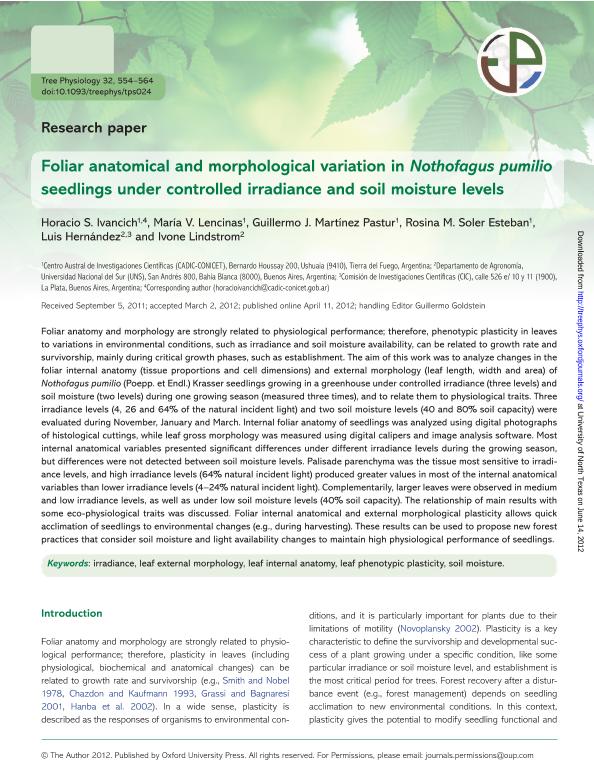Artículo
Foliar anatomical and morphological variation in Nothofagus pumilio seedlings under controlled irradiance and soil moisture levels
Ivancich, Horacio Simón ; Lencinas, María Vanessa
; Lencinas, María Vanessa ; Martínez Pastur, Guillermo José
; Martínez Pastur, Guillermo José ; Soler Esteban, Rosina Matilde
; Soler Esteban, Rosina Matilde ; Hernández, Luis; Lindstrom, Ivone
; Hernández, Luis; Lindstrom, Ivone
 ; Lencinas, María Vanessa
; Lencinas, María Vanessa ; Martínez Pastur, Guillermo José
; Martínez Pastur, Guillermo José ; Soler Esteban, Rosina Matilde
; Soler Esteban, Rosina Matilde ; Hernández, Luis; Lindstrom, Ivone
; Hernández, Luis; Lindstrom, Ivone
Fecha de publicación:
05/2012
Editorial:
Oxford University Press
Revista:
Tree Physiology
ISSN:
0829-318X
Idioma:
Inglés
Tipo de recurso:
Artículo publicado
Clasificación temática:
Resumen
Foliar anatomy and morphology are strongly related to physiological performance; therefore, phenotypic plasticity in leaves to variations in environmental conditions, such as irradiance and soil moisture availability, can be related to growth rate and survivorship, mainly during critical growth phases, such as establishment. The aim of this work was to analyze changes in the foliar internal anatomy (tissue proportions and cell dimensions) and external morphology (leaf length, width and area) of Nothofagus pumilio (Poepp. et Endl.) Krasser seedlings growing in a greenhouse under controlled irradiance (three levels) and soil moisture (two levels) during one growing season (measured three times), and to relate them to physiological traits. Three irradiance levels (4, 26 and 64% of the natural incident light) and two soil moisture levels (40 and 80 soil capacity) were evaluated during November, January and March. Internal foliar anatomy of seedlings was analyzed using digital photographs of histological cuttings, while leaf gross morphology was measured using digital calipers and image analysis software. Most internal anatomical variables presented significant differences under different irradiance levels during the growing season, but differences were not detected between soil moisture levels. Palisade parenchyma was the tissue most sensitive to irradiance levels, and high irradiance levels (64% natural incident light) produced greater values in most of the internal anatomical variables than lower irradiance levels (4-24% natural incident light). Complementarily, larger leaves were observed in medium and low irradiance levels, as well as under low soil moisture levels (40% soil capacity). The relationship of main results with some eco-physiological traits was discussed. Foliar internal anatomical and external morphological plasticity allows quick acclimation of seedlings to environmental changes (e.g., during harvesting). These results can be used to propose new forest practices that consider soil moisture and light availability changes to maintain high physiological performance of seedlings.
Archivos asociados
Licencia
Identificadores
Colecciones
Articulos(CADIC)
Articulos de CENTRO AUSTRAL DE INVESTIGACIONES CIENTIFICAS
Articulos de CENTRO AUSTRAL DE INVESTIGACIONES CIENTIFICAS
Citación
Ivancich, Horacio Simón; Lencinas, María Vanessa; Martínez Pastur, Guillermo José; Soler Esteban, Rosina Matilde; Hernández, Luis; et al.; Foliar anatomical and morphological variation in Nothofagus pumilio seedlings under controlled irradiance and soil moisture levels; Oxford University Press; Tree Physiology; 32; 5; 5-2012; 554-564
Compartir
Altmétricas



